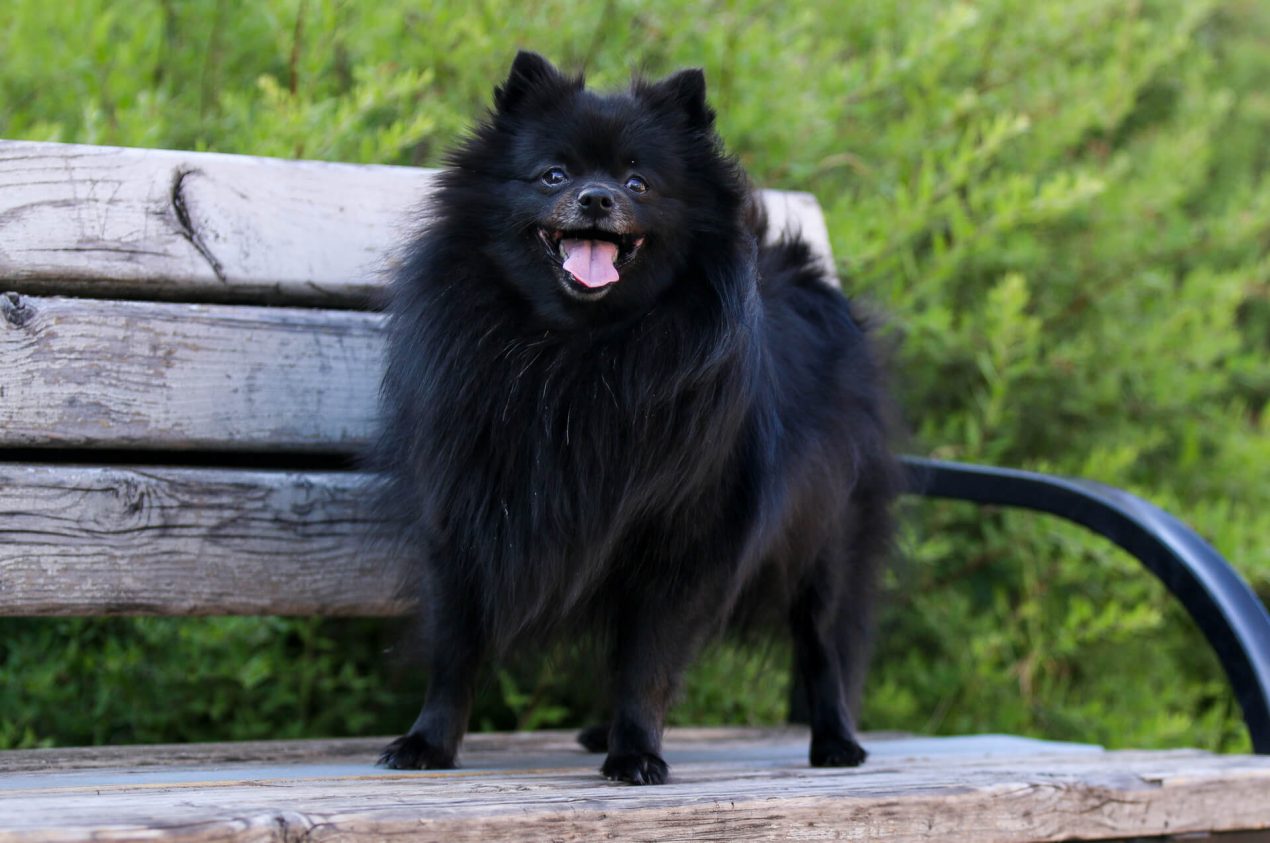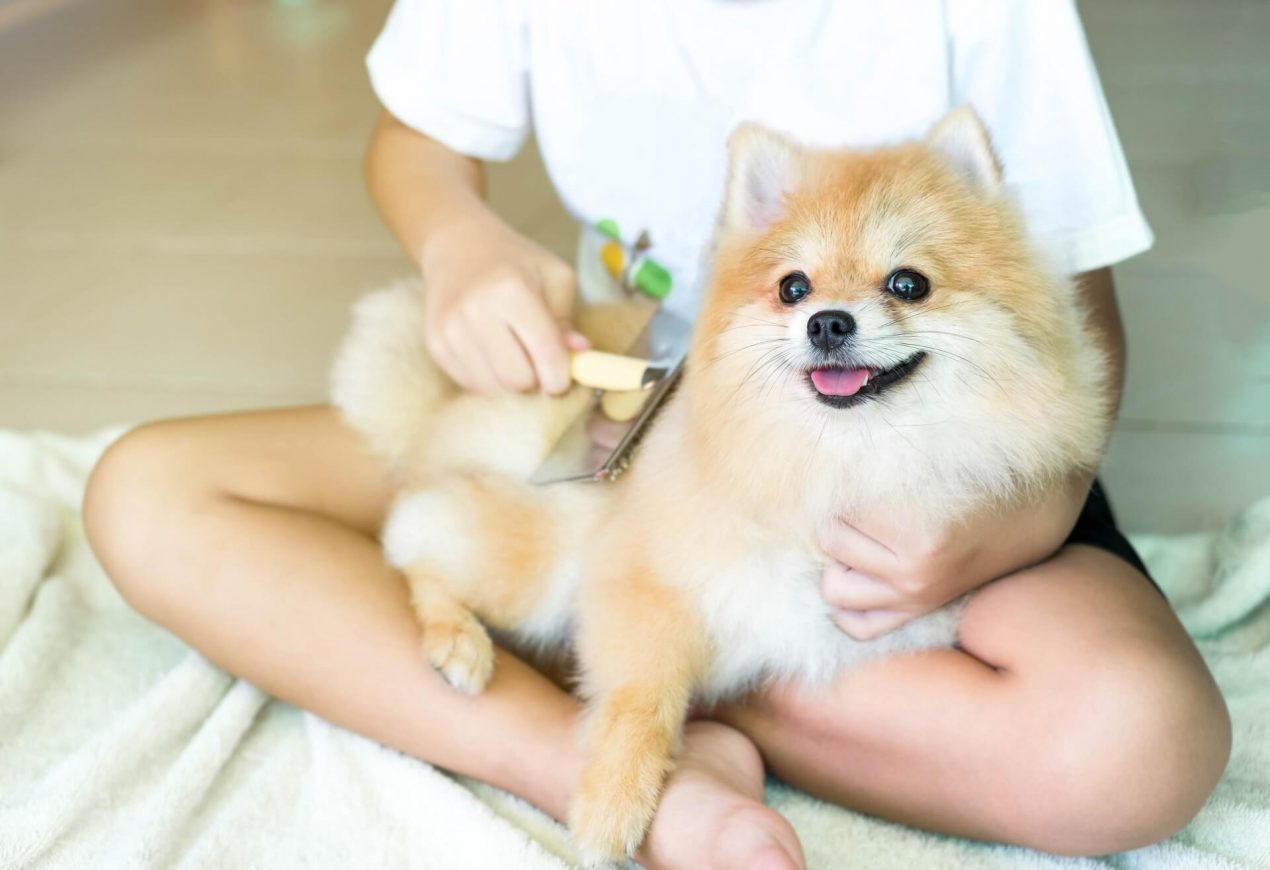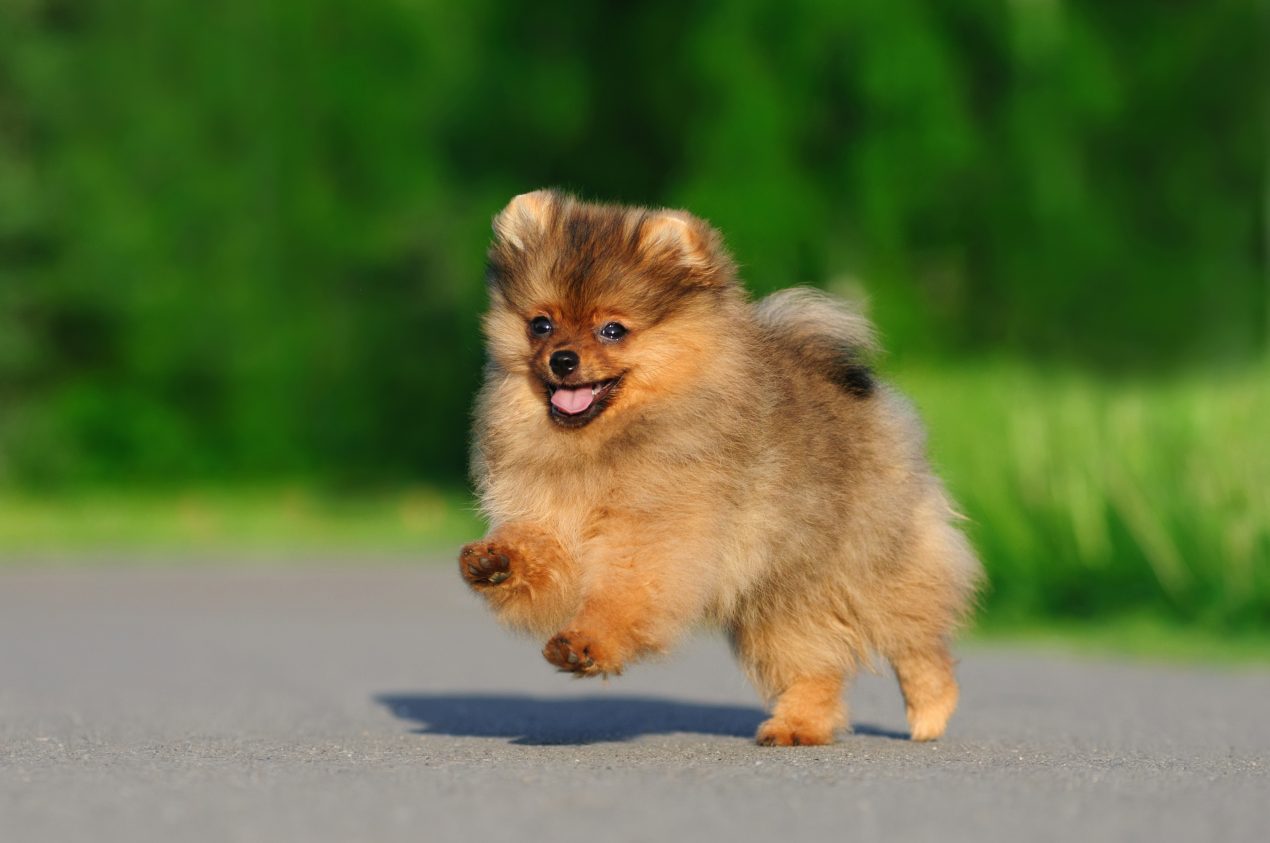The Pomeranian, also known as the Zwergspitz (german), is a lively and affectionate dog breed originating from Germany. Internationally, the breed falls under the FCI Group 5 “Spitz and Primitive Types” in Section 4 “European Spitz.” They enjoy widespread popularity worldwide. Learn more about the characteristics of this breed in the profile below.
History of the Pomeranian
The history of the Pomeranian is genuinely fascinating. Originally descending from the Spitz, which comes in various sizes and colors, ancient depictions on Mycenaean terracotta and Greek vases already showcased dogs that can be considered a kind of “proto-Spitz.” Over 200 years ago, the English brought particularly small Spitz dogs from Pomerania to England. Through selective breeding, they reduced the size of these dogs, naming them Pomeranian after their region of origin.
Germany also has a special connection to the Pomeranian. In fact, the “Zwergspitz” originated there and received recognition in the 18th century. Initially, these dogs were larger and suited for various tasks. However, over time, breeders emphasized making them ideal companion dogs, influencing their size. Finally, in the late 19th and early 20th centuries, large breeding associations officially recognized them.
The increasing popularity of the Pomeranian, both in Germany and internationally, can be attributed to its charming appearance and lively personality. If you delve into the roots of the breed, you’ll find that it has its origins in the large sled dog breeds of the Arctic North. Over the years, breeders refined this breed, creating the modern Pomeranian with its impressive coat and friendly nature.
Breed Overview
GROUP: Toy
HEIGHT: 6 to 7 inches
WEIGHT: 3 to 7 pounds
TEMPERAMENT: Bold, alert, lively, affectionate
COAT: Long double coat
COAT COLOR: Comes in many colors and combinations, though the most common are red, orange, cream, sable, black, brown, and blue
HYPOALLERGENIC: No
LIFE SPAN: 12 to 16 years
Temperament and Character
The Pomeranian is an extremely affectionate, people-oriented dog that prefers to be always close to you. These small dogs are known for their intelligence, loyalty, and adaptability. Therefore, you can observe how quickly they learn new commands or tricks. Despite their small size, they display remarkable alertness and can prove to be excellent guardians of your home.
When it comes to staying alone at home, Pomeranians don’t particularly like it. Nevertheless, with proper acclimatization from an early age, it is possible to leave them alone for a few hours. Otherwise, they might become restless and vocally express their dissatisfaction. Additionally, they sometimes exhibit provocative and challenging behavior towards other dogs, even if those are much larger.
However, when properly trained, these dogs are gentle and get along well with children and other pets. This is because, when correctly socialized, they are highly adaptable and respectful. Therefore, Pomeranians are popular choices for beginner dog owners. By the way, if you’re wondering how easy or difficult their training is: they are curious and respond positively to affirmation, making training phases more manageable.
Appearance of the Pomeranian
The Pomeranian, the smallest of the five German Spitz varieties, stands out with a withers height between 18 and 22 centimeters. One of its most striking features is the dense, fluffy coat with abundant woolly underfur. Typically, coat colors include black, brown, white, orange, and gray, but you can also find variations in cream, cream-sable, orange-sable, black-and-tan, or spotted. Interestingly, some puppies may change their coat color with age, with, for example, cream-colored puppies often becoming brown.
The appearance of the Pomeranian strongly resembles a fox: pointed ears, bright expressive eyes, and a short, tapering snout define its face. Add to that a mane-like collar around the neck and a bushy tail carried skillfully over the back. Its small, round paws complete the characteristic appearance.

Puppy Training
As cute as the Pomeranian is, there should be no compromises in its training. From the first day, you should take your puppy seriously and consistently show it the rules. Especially in puppyhood, where they are most receptive, you can make rapid progress through praise and clear guidelines, quickly nipping undesirable behavior in the bud.
But not only that: playing is the best way for them to learn new commands. Therefore, it is wise to make their training playful. However, it is of immense importance to start socialization early to teach them how to interact with different people, other dogs, and pets. This not only helps minimize potential behavioral issues like excessive barking but also builds their confidence in various environments.
Excessive barking and separation anxiety can indeed occur in Pomeranians. While barking can be reduced through targeted training and continuous socialization, creating a secure environment and gradually acclimating the puppy to short separation periods help with separation anxiety. With praise and consistency, you can achieve quick successes and prevent unwanted behavior in your protege.
You might also consider visiting a dog school. The training offered there can be a valuable addition and help you give your little companion the best possible start in life.
Training of a Pomeranian
Training a Pomeranian can be a highly rewarding experience due to their intelligence and eagerness to please. It is crucial to start training early, especially focusing on socialization and basic commands. Socialization helps the Pomeranian feel comfortable when interacting with other animals and people.
In Pomeranian training, you should begin with basic commands such as “Sit,” “Stay,” and “Come.” These commands form the foundation for a well-behaved pet and help establish a strong bond between you and your dog. The use of positive reinforcement is crucial for success in Pomeranian training. Praise, treats, and toys are excellent rewards for this dog when it correctly follows a command.
Some challenging behaviors may arise during training. For example, the Pomeranian can be stubborn at times. Consistency and patience are key in such cases. Keeping training sessions short and entertaining helps maintain the Pomeranian’s attention and promotes a positive learning experience.
Activities with the Pomeranian
The Pomeranian is both lively and energetic. This small dog loves to play, frolic, and requires daily exercise to stay in top shape. The intensity of the exercises doesn’t always have to be high, but regular activities should be part of the routine. A daily walk combined with playtime keeps its energy balanced. Thanks to its small size, you can easily take it anywhere and explore different walking routes together.
Additionally, the Pomeranian particularly enjoys games that challenge its intelligence and agility. Whether it’s short ball games, learning tricks, or agility training, it is enthusiastic about almost anything. Dog dancing and obedience are additional activities that bring it joy. Therefore, it’s essential to mentally engage it at home as well, or it might quickly get bored and seek its own entertainment.
Finally, allowing it to interact with other dogs can be beneficial. This not only promotes physical activity but also strengthens its social skills. This way, your Pomeranian remains healthy, happy, and well-exercised.

Care of a Pomeranian
Pomeranians have a unique and dense coat that surprisingly requires straightforward care. Despite its abundance, the Pomeranian’s coat is relatively easy to maintain. The special feature: hardly any matting occurs due to its standing fur. For the well-being of the dog, it is recommended to brush the coat regularly, preferably two to three times a week. It is advised to brush against the grain and then wipe the Pomeranian with a damp, soft cloth afterward. This reduces hair loss in the following days.
Moreover, there are special brushes and combs that are optimal for grooming a Pomeranian’s coat.
Another essential aspect of caring for this breed is dental hygiene. Similar to other small dog breeds, Pomeranians are prone to dental problems. To prevent tartar and gum disease, you should brush your furry friend’s teeth regularly. Special dog toothpaste and a dog toothbrush are available for this purpose. Providing dental chews can also help prevent dental issues.
Nail care should not be neglected either. Trim your Pomeranian’s nails at regular intervals to avoid ingrown nails. You can either do this yourself or visit a professional dog salon.
How to Feed a Pomeranian
The nutritional needs of a Pomeranian are relatively straightforward, but it’s important to ensure a balanced diet that includes all necessary nutrients. A high-quality dog food formulated for small breeds can be a good choice.
The amount of food you give to your Pomeranian depends on its age, size, and activity level. Generally, they require about 1/4 to 1/2 cup of dry food per day, divided into two meals.
It’s also crucial to watch out for potential allergies or intolerances. Some Pomeranians may be sensitive to specific ingredients in dog food. If you notice skin or digestive issues, it might be a good idea to check the ingredient list on its food and, if necessary, try a different brand or formula.
Maintaining a regular feeding routine and monitoring your Pomeranian’s weight help keep it healthy and maintain an ideal weight. It’s also advisable to schedule regular vet visits to ensure your Pomeranian’s nutritional needs are met and that it maintains a healthy weight.
Health and Genetic Conditions
Healthwise, Pomeranians are generally a robust breed. However, like all dog breeds, they can have certain hereditary health problems. These may include eye conditions such as cataracts, progressive retinal atrophy (PRA), and corneal dystrophy. Skin conditions, joint problems, and orthopedic challenges like patellar luxation are also not uncommon.
Therefore, it’s essential to visit the vet regularly. These visits help detect health issues early and provide timely treatment. Keeping vaccinations up to date is crucial to proactively prevent various diseases. On average, the life expectancy of a Pomeranian is between 12 and 16 years. However, health problems can shorten this timeframe.
Furthermore, if you’re considering getting a Pomeranian, it’s advisable to contact a reputable breeder. A good breeder tests their breeding dogs for genetic anomalies and selects them with care. This minimizes the risk of hereditary diseases.
How to Care for a Pomeranian
The Pomeranian is an adaptable breed that does well in both urban apartments and houses with large yards. Despite their flexibility, they like to be close to their family and may experience separation anxiety when left alone. A comfortable space where they feel secure, along with daily walks and playtimes, is essential for their well-being.
Is a Pomeranian Right for Me?
It’s important to note that the Pomeranian is not a lap dog. Pomeranians remain active well into old age and require a lot of engagement. Therefore, getting a Pomeranian puppy should be a well-thought-out decision. They need an active owner with enough time to provide physical and mental stimulation. If you’re sure about the breed, you need to find a reputable breeder.
Many breeders ask around $1,000 for a purebred puppy with papers and vaccinations. An excellent alternative to a breeder puppy is adopting one from a shelter. For a small adoption fee, you can give a Pomeranian in need a new chance at life with you.
The financial responsibility for a Pomeranian can add up. Initial costs may include the purchase price, vaccinations, deworming, and basic supplies such as a leash, collar, and dog bed. Ongoing costs include food, regular vet visits, grooming products, and potential health expenses. It’s also advisable to have an emergency fund for unexpected health problems or accidents.
Caring for a Pomeranian is a long-term financial commitment, and it’s important to be ready to provide the necessary resources for your Pomeranian to have a happy, healthy life.

Similar and Related Breeds
Spitz breeds are particularly popular dogs. Among them, you’ll find the Kleinspitz, Mittelspitz, and Wolfsspitz. The differences between these breeds mainly lie in their size, with the Pomeranian being the smallest variant, and the color of their fur. Additionally, related breeds such as the Eurasier and Samoyed belong to this family. Other breeds related to the Spitz family include the Eurasier and Samoyed.
If you’re thinking about a Pomeranian, it stands out for its luxurious coat and friendly, outgoing temperament. Unlike other small breeds like the Chihuahua or Yorkshire Terrier, Pomeranians are often less territorial and aggressive, making them a suitable choice for families with children or other pets.
However, it’s essential to thoroughly research the specific needs and characteristics of the desired breed. Each has its own traits and requirements, so choosing a breed that truly fits your lifestyle and preferences is crucial.
Interesting and Fun Facts
The small Spitz has been popular in many parts of Europe for several centuries. For example, not only did Queen Victoria and the painter Michelangelo own representatives of the breed, but even Martin Luther had one. Even today, celebrities have Pomeranians as popular furry companions. Stars like Gwen Stefani, Hillary Duff, and Sylvester Stallone own representatives of the breed. Even Elvis Presley had a Pomeranian named Edmund. Due to their cute appearance and cheerful character, Pomeranians are also very popular on social media.
Do you have a Pomeranian, or are you thinking of getting one? Share in the comments what makes them special in your opinion!


